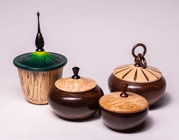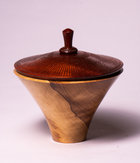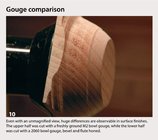john lucas
AAW Forum Expert
For the last month I've been doing a sharpening grit test. I was having a discussion with Steve Jones who makes turning videos using the skew. I claimed that sharpening to a higher grit would make a cleaner finish cut. He didn't think so. My Friend John Jordan used to say that 60 grit was as high as you needed to go. I felt this needed testing. So I mounted a 36 grit blue AOX wheel to my grinder. It has a 350 grit CBN on the other side. I turned a lot of projects over the last month. Turned out of Elm, Red Heart, Poplar, Spalted maple, Cocobolo, Birds eye maple, Hard maple,Walnut, Bolivian Rosewood, Ebony, Madrone,and Yellow heart. I used 3 bowl gouges of different steels, one spindle gouge, and a skew. What I would do is rough out the shape. Then I would sharpen the tool on one of the stones. I would make a finishing cut. Then I would resharpen on the other stone a make the same cut as accurately as I could. In all these woods there was no difference in the quality of the cut. these were easily sanded using 220 grit except for the Bolivian Rosewood that had the smallest of tearout in two small areas that took 180 grit. After seeing that tearout I cut that piece again with each sharpening grit and still got the same tearout in the same place. Normally when this happens I switch to a spindle gouge with a 35 degree edge and it solves the problem but this was a test about the tools
In my opinion the quality of the cut is due to how fast you push the tool through the wood. You have to push the tool no faster than the wood want's to be cut. This will vary with the wood of course. I use a very short main bevel on my tools except for the skew. This helps me "feel" the cut. I relax my grip using just finger tip pressure and let the tool cut at the rate it want's to cut. This is a lot slower than you think. If you force the cut at all you get a less than perfect surface.
Yesterday I did 2 more tests. I had a punky piece of Maple. I decided to turn a 7" bowl out of it. I roughed it out and did my same test with a 40 degree bowl gouge. I made 2 cuts and they were identical. There was very minor tearout that occured in 2 places and was pretty much the same off of both grinds. I soaked the wood with sanding sealer and let it dry. I did the same test. cut with one grit, then applied sanding sealer again and cut with the next grit. There was no difference and no tearout. then I took a Sycamore spindle and put it on the lathe. I rounded it over with my SRG and then took my skew that had been sharpened on the 350 grit wheel. It was then honed using a 1200 grit diamond hone and then stropped on my tormek. I cut half the spindle with this. Then I reground the skew using my 36 grit stone. I used it straight off the grinder without removing the burr. I got the same quality of cut. Again I am using the same light cut and forward speed.
This was quite shocking to me because I can tell you from experience that sharpening my hand planes and my carving tools to mirror finish makes a huge difference in the quality of cut.
Is there a reason to sharpen at higher grits. Yes. It's been proven that sharpening to higher grits promotes edge life. the second reason is that higher grits remove less steel and your tools will last longer. Very high grits like 600 remove so little steel that unless your sharpening skills are really good you may not grind all the way to the tip and not get a sharp tool. I learned this years ago when taking a class with Frank Sudol. He had us sharpening on a belt sander with 600 grit belt. I was not that good at sharpening and could not get a sharp edge. Now with better skills and good sharpening jigs I can easily get a perfect edge off my 350 grit wheel. Below are some of the projects
In my opinion the quality of the cut is due to how fast you push the tool through the wood. You have to push the tool no faster than the wood want's to be cut. This will vary with the wood of course. I use a very short main bevel on my tools except for the skew. This helps me "feel" the cut. I relax my grip using just finger tip pressure and let the tool cut at the rate it want's to cut. This is a lot slower than you think. If you force the cut at all you get a less than perfect surface.
Yesterday I did 2 more tests. I had a punky piece of Maple. I decided to turn a 7" bowl out of it. I roughed it out and did my same test with a 40 degree bowl gouge. I made 2 cuts and they were identical. There was very minor tearout that occured in 2 places and was pretty much the same off of both grinds. I soaked the wood with sanding sealer and let it dry. I did the same test. cut with one grit, then applied sanding sealer again and cut with the next grit. There was no difference and no tearout. then I took a Sycamore spindle and put it on the lathe. I rounded it over with my SRG and then took my skew that had been sharpened on the 350 grit wheel. It was then honed using a 1200 grit diamond hone and then stropped on my tormek. I cut half the spindle with this. Then I reground the skew using my 36 grit stone. I used it straight off the grinder without removing the burr. I got the same quality of cut. Again I am using the same light cut and forward speed.
This was quite shocking to me because I can tell you from experience that sharpening my hand planes and my carving tools to mirror finish makes a huge difference in the quality of cut.
Is there a reason to sharpen at higher grits. Yes. It's been proven that sharpening to higher grits promotes edge life. the second reason is that higher grits remove less steel and your tools will last longer. Very high grits like 600 remove so little steel that unless your sharpening skills are really good you may not grind all the way to the tip and not get a sharp tool. I learned this years ago when taking a class with Frank Sudol. He had us sharpening on a belt sander with 600 grit belt. I was not that good at sharpening and could not get a sharp edge. Now with better skills and good sharpening jigs I can easily get a perfect edge off my 350 grit wheel. Below are some of the projects
Attachments
Last edited:



